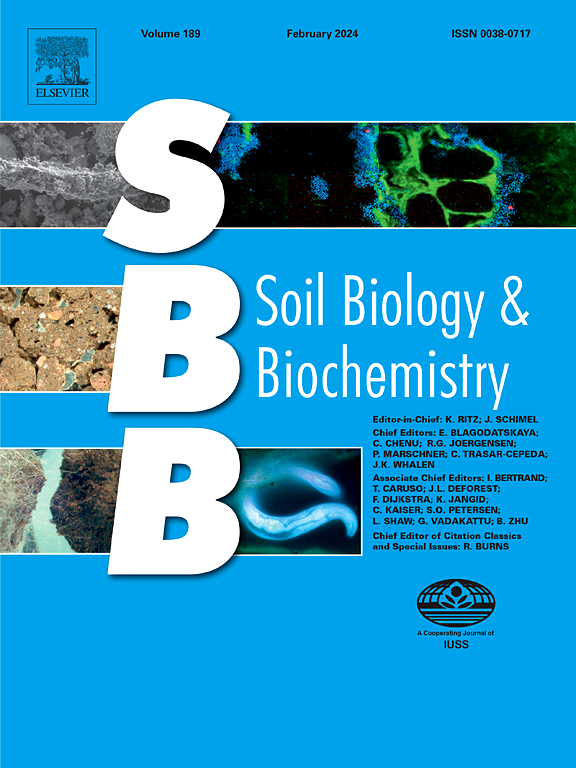微生境比生态系统类型更能决定春尾物种的营养地位
IF 10.3
1区 农林科学
Q1 SOIL SCIENCE
引用次数: 0
摘要
营养可塑性可能会加剧土壤动物物种之间的竞争,降低其多样性,这通常是由土壤的营养生态位分化和垂直微分层驱动的。土壤分解者如弹子线虫可以随着微生境的变化而改变其营养生态位(垂直变化)和不同生态系统类型(水平变化),但这些变化需要进一步研究。在这里,我们比较了40个森林林分中27种弹子线虫在凋落物和土层之间的稳定同位素值,这些林分包括欧洲山毛榉、挪威云杉、道格拉斯冷杉的单一栽培,或欧洲山毛榉与两种针叶树中的任何一种的混合栽培(中欧)。结果表明,无论何种林型,种内弹弹的δ15N值在土壤中均高于凋落物层。这种增加与革兰氏阴性菌的生物量相关,而与真菌无关。山毛榉林中弹桃的δ13C值显著富集,而道格拉斯冷杉林和挪威云杉林的δ13C值相似,表明两种针叶林对弹桃基础资源利用的影响相似。总的来说,结果表明弹线虫改变了它们的饮食,消耗了它们所定殖的土壤层中可用的当地资源,细菌在驱动它们的营养位置变化方面发挥了比以前假设的更重要的作用。相比之下,collebolan在不同生态系统类型之间的营养地位一致表明,尽管地上植被类型发生了很大变化,土壤动物在土壤微生境中仍能获得相似的食物来源。综上所述,生态系统类型的变化对弹线虫可利用的资源影响不大,弹线虫可能会选择性地取食土壤微生境中的特定资源。相比之下,资源类型和土壤微生境在土壤深度上的变化对坡头蝗的营养生态位影响更大,这需要可塑性来适应它们的饮食。本文章由计算机程序翻译,如有差异,请以英文原文为准。
Microhabitat more than ecosystem type determines the trophic position of springtail species
Trophic plasticity may intensify competition among soil animal species and reduce their high diversity, which is often maintained by trophic niche differentiation and vertical microstratification in soils. Soil decomposers such as Collembola can shift their trophic niche with changing microhabitats across soil depths (vertical variation) and between different ecosystem types (horizontal variation), but these variations need further investigation. Here, we compared the stable isotope values of 27 Collembola species between litter and soil layers in 40 forest stands, comprising monocultures of European beech, Norway spruce, Douglas fir, or mixtures of European beech with either of the two conifer species. The results showed that the δ15N values of Collembola within species were uniformly higher in soil than in the litter layer irrespective of forest type. This increase correlated with the biomass of Gram-negative bacteria but not with that of fungi. The δ13C values of Collembola were significantly enriched in beech forests, but were similar in Douglas fir and Norway spruce forests indicating similar effects of the two coniferous species on the basal resource use of Collembola. Overall, the results suggest that Collembola shift their diet to consume local resources available in the respective soil layer they colonize, with bacteria playing a more important role in driving variations in their trophic positions than previously assumed. By contrast, the consistent trophic position of Collembola between ecosystem types suggest access to similar food sources in the soil microhabitat, despite large changes in aboveground vegetation type. Overall this study suggests that changes in ecosystem types has little influence on the resources accessible to Collembola which presumably selectively feed on specific resources in the soil microhabitat. By contrast, variations in resource types and soil microhabitats across soil depth more strongly affect the trophic niche of Collembola, which requires plasticity to adapt to their diet.
求助全文
通过发布文献求助,成功后即可免费获取论文全文。
去求助
来源期刊

Soil Biology & Biochemistry
农林科学-土壤科学
CiteScore
16.90
自引率
9.30%
发文量
312
审稿时长
49 days
期刊介绍:
Soil Biology & Biochemistry publishes original research articles of international significance focusing on biological processes in soil and their applications to soil and environmental quality. Major topics include the ecology and biochemical processes of soil organisms, their effects on the environment, and interactions with plants. The journal also welcomes state-of-the-art reviews and discussions on contemporary research in soil biology and biochemistry.
 求助内容:
求助内容: 应助结果提醒方式:
应助结果提醒方式:


